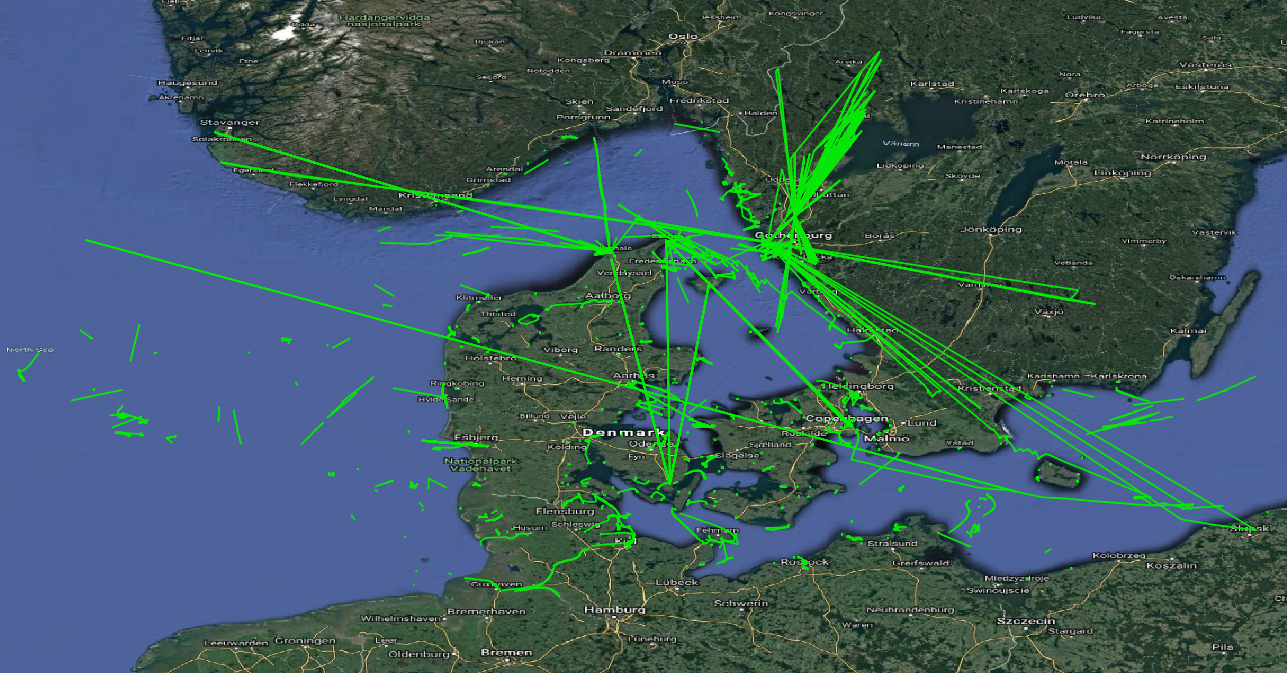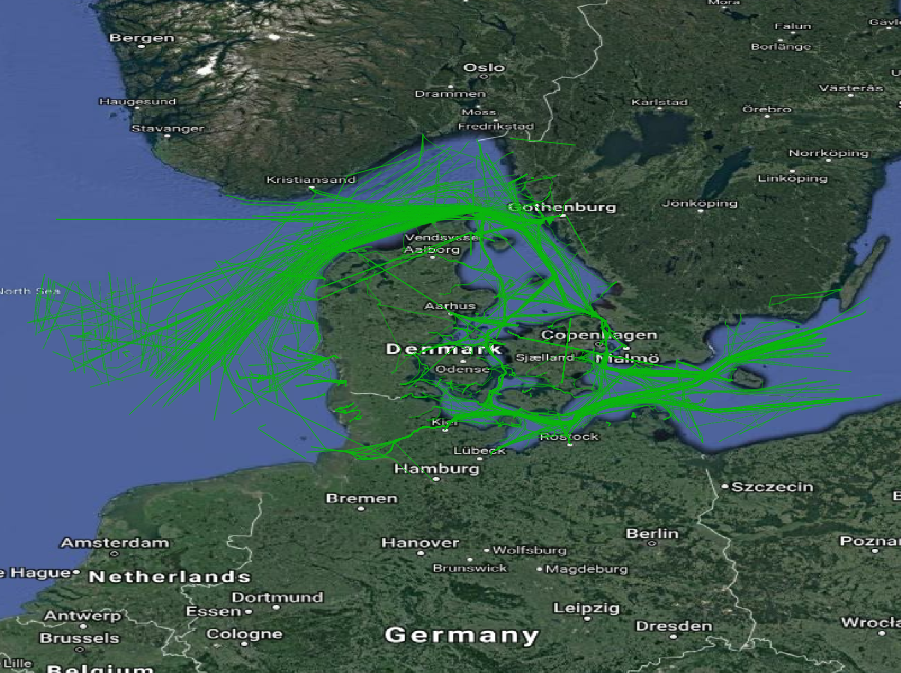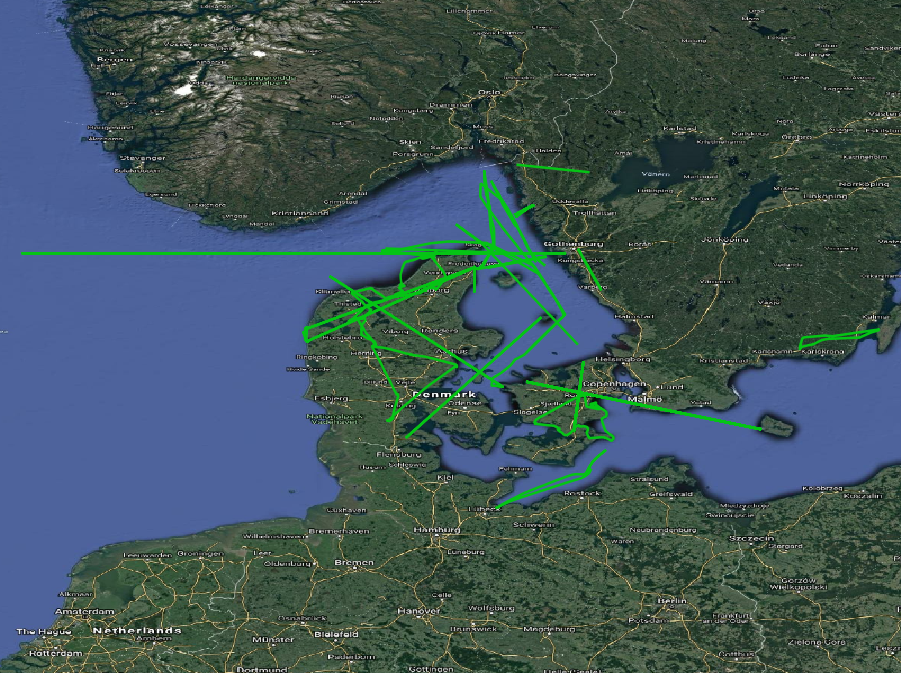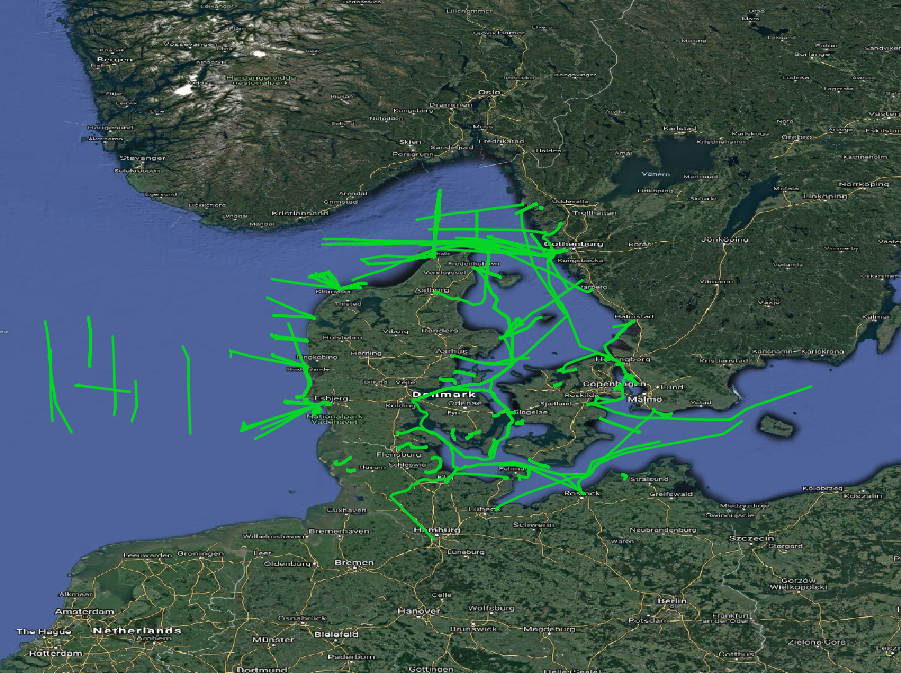The total distance traveled by all ships:
SELECT SUM( length( Trip ) ) FROM Ships; --500433519.121321
This query uses the length function to compute per trip the sailing distance in meters. We then aggregate over all trips and calculate the sum. Let's have a more detailed look, and generate a histogram of trip lengths:
WITH buckets (bucketNo, RangeKM) AS (
SELECT 1, floatrange '[0, 0]' UNION
SELECT 2, floatrange '(0, 50)' UNION
SELECT 3, floatrange '[50, 100)' UNION
SELECT 4, floatrange '[100, 200)' UNION
SELECT 5, floatrange '[200, 500)' UNION
SELECT 6, floatrange '[500, 1500)' UNION
SELECT 7, floatrange '[1500, 10000)' ),
histogram AS (
SELECT bucketNo, RangeKM, count(MMSI) as freq
FROM buckets left outer join Ships on (length(Trip)/1000) <@ RangeKM
GROUP BY bucketNo, RangeKM
ORDER BY bucketNo, RangeKM
)
SELECT bucketNo, RangeKM, freq,
repeat('▪', ( freq::float / max(freq) OVER () * 30 )::int ) AS bar
FROM histogram;
--Total query runtime: 5.6 secs
bucketNo, bucketRange, freq bar
1; "[0,0]"; 303; ▪▪▪▪▪
2; "(0,50)"; 1693; ▪▪▪▪▪▪▪▪▪▪▪▪▪▪▪▪▪▪▪▪▪▪▪▪▪▪▪▪▪▪
3; "[50,100)"; 267; ▪▪▪▪▪
4; "[100,200)"; 276; ▪▪▪▪▪
5; "[200,500)"; 361; ▪▪▪▪▪▪
6; "[500,1500)"; 86; ▪▪
7; "[1500,10000)"; 6;
Surprisingly there are trips with zero length. These are clearly noise that can be deleted. Also there are very many short trips, that are less than 50 km long. On the other hand, there are few long trips that are more than 1,500 km long. Let's visualize these last two cases in Figure 1.3, “Visualizing trips with abnormal lengths”. They look like noise. Normally one should validate more, but to simplify this module, we consider them as noise, and delete them.
DELETE FROM Ships WHERE length(Trip) = 0 OR length(Trip) >= 1500000; -- Query returned successfully in 7 secs 304 msec.
Now the Ships table looks like Figure 1.4, “Ship trajectories after filtering”.
Let's have a look at the speed of the ships. There are two speed values in the data; the speed calculated from the spatiotemporal trajectory speed(Trip), and the SOG attribute. Optimally, the two will be the same. A small variance would still be OK, because of sensor errors. Note that both are temporal floats. In the next query, we compare the averages of the two speed values for every ship:
SELECT ABS(twavg(SOG) * 1.852 - twavg(speed(Trip))* 3.6 ) SpeedDifference FROM Ships ORDER BY SpeedDifference DESC; --Total query runtime: 8.2 secs --990 rows retrieved. SpeedDifference NULL NULL NULL NULL NULL 107.861100067879 57.1590253627668 42.4207839833568 39.5819188407125 33.6182789410313 30.9078594633161 26.514042447366 22.1312646226031 20.5389022294181 19.8500569368283 19.4134688682774 18.180139457754 17.4859077178001 17.3155991287105 17.1739822139821 12.9571603234404 12.6195380496344 12.2714437568609 10.9619033557275 10.4164745930929 10.3306155308426 9.46457823214455 ...
The twavg computes a time-weighted average of a temporal float. It basically computes the area under the curve, then divides it by the time duration of the temporal float. By doing so, the speed values that remain for longer durations affect the average more than those that remain for shorter durations. Note that SOG is in knot, and Speed(Trip) is in m/s. The query converts both to km/h.
The query shows that 26 out of the 990 ship trajectories in the table have a difference of more than 10 km/h or NULL. These trajectories are shown in Figure 1.5, “Ship trajectories with big difference between speed(Trip) and SOG”. Again they look like noise, so we remove them.
Now we do a similar comparison between the calculated azimuth from the spatiotemporal trajectory, and the attribute COG:
SELECT ABS(twavg(COG) - twavg(azimuth(Trip)) * 180.0/pi() ) AzimuthDifference FROM Ships ORDER BY AzimuthDifference DESC; --Total query runtime: 4.0 secs --964 rows retrieved. 264.838740787458 220.958372832234 180.867071483688 178.774337481463 154.239639388087 139.633953692907 137.347542674865 128.239459879571 121.107566199195 119.843262642657 116.685117326047 116.010477588934 109.830338231363 106.94301191915 106.890186229337 106.55297972109 103.20192549283 102.585009756697 ...
Here we see that the COG is not as accurate as the SOG attribute. More than 100 trajectories have an azimuth difference bigger than 45 degrees. Figure 1.6, “Ship trajectories with big difference between azimuth(Trip) and COG” visualizes them. Some of them look like noise, but some look fine. For simplicity, we keep them all.



